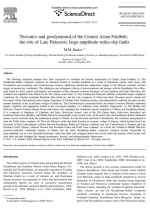Добрый день, Коллеги. Важное сообщение, просьба принять участие. Музей Ферсмана ищет помощь для реставрационных работ в помещении. Подробности по ссылке
Tectonics and geodynamics of the Central Asian Foldbelt: the role of Late Paleozoic large-amplitude strike-slip faults
The following structural elements have been recognized to constitute the tectonic demarcation of Central Asian Foldbelt: (1) The Kazakhstan–Baikal composite continent, its basement formed in Vendian–Cambrian as a result of Paleoasian oceanic crust, along with Precambrian microcontinents and Gondwana-type terranes, subduction beneath the southeastern margin of the Siberian continent (western margin in present-day coordinates). The subduction and subsequent collision of microcontinents and terranes with the Kazakhstan–Tuva–Mongolia island arc led to crustal consolidation and formation of the composite-continent basement. In Late Cambrian and Early Ordovician, this continent was separated from Siberia by the Ob’–Zaisan ocean basin. (2) The Vendian and Paleozoic Siberian continental margin complexes comprising the Vendian–Cambrian Kuznetsk–Altai island arc and the rock complexes of Ordovician–Early Devonian passive margin and Devonian to Early Carboniferous active margin. Fragments of Vendian–Early Cambrian oceanic crust represented by ophiolite and paleo-oceanic mounds dominate in the accretionary wedges of island arc. The Gondwana-type continental blocks are absent in western Siberian continental margin complexes and supposedly formed at the convergent boundary of a different ocean, probably, Paleopacific. (3) The Middle–Late Paleozoic Charysh–Terekta–Ulagan–Sayan suture-shear zone separating the continental margin complexes of Siberia and Kazakhstan–Baikal. It is composed of fragments of Cambrian and Early Ordovician oceanic crust of the Ob’–Zaisan basin, Ordovician blueschists and Cambrian–Ordovician turbidites, and Middle Paleozoic metamorphic rocks of shear zones. In the suture zone, the Kazakhstan–Baikal continental masses moved westward along the southeastern margin of Siberia. In Late Devonian and Early Carboniferous, the continents amalgamated to form the North Asian continent. (4) The Late Paleozoic strike-slip faults forming an orogenic collage of terranes, which resulted from Late Devonian to Early Carboniferous collision between Kazakhstan–Baikal and Siberian continents and Late Carboniferous to Permian and Late Permian to Early Triassic collisions between East European Craton and North Asian continent. As a result, the Vendian to Middle Paleozoic accretion-collisional continental margins of Siberia and the entire Kazakhstan–Baikal composite continent became fragmented by large-amplitude (up to a few thousand kilometers) strike-slip faults and conjugate thrusts into several strike-slip terranes, which mixed with each other and thus disrupted the original geodynamic, tectonic, and paleogeographic demarcation.




